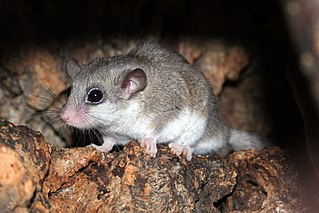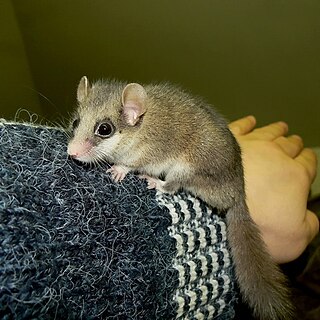
A dormouse is a rodent of the family Gliridae. Dormice are nocturnal animals found in Africa, Asia, and Europe. They are named for their long, dormant hibernation period of six months or longer.
The long-tailed dwarf hamster is a species of rodent in the family Cricetidae. It is found in China, Kazakhstan, Mongolia, and Russia.
The West African shaggy rat is a species of rodent in the family Muridae. It is found in Benin, Cameroon, Ivory Coast, Gambia, Ghana, Guinea, Guinea-Bissau, Liberia, Mali, Nigeria, Senegal, Sierra Leone, and Togo. Its natural habitats are subtropical or tropical seasonally wet or flooded lowland grassland and swamps. It is a common species and the International Union for Conservation of Nature has rated its conservation status as being of "least concern".
The dune hairy-footed gerbil, or the Namib dune gerbil is a species of rodent found only in Namibia. Its natural habitat is temperate desert where it lives in loose sand among sand dunes, feeding opportunistically on arthropods, seeds and green vegetation.
The Mount Oku hylomyscus is a species of rodent in the family Muridae. Found only on Mount Oku, Cameroon, in tropical Central Africa, its natural habitat is tropical moist montane forests. It has a very small range and is threatened by habitat destruction, so the International Union for Conservation of Nature has rated its conservation status as being "critically endangered".

The little desert pocket mouse is a species of small rodent in the family Heteromyidae. It is endemic to Baja California in Mexico.

The northern three-toed jerboa is a species of rodent in the family Dipodidae. It is the only extant species within the genus Dipus. It ranges across Iran, Uzbekistan, Turkmenistan, Kazakhstan, Russia, China and Mongolia. A common species, the International Union for Conservation of Nature rates it as being of "least concern".

The Asian garden dormouse or large-eared garden dormouse, is a species of rodent in the family Gliridae. It is found in Egypt, Iraq, Israel, Jordan, Lebanon, Libya, Saudi Arabia, Syria and Turkey. Its natural habitats are temperate forests, subtropical or tropical dry shrubland, Mediterranean-type shrubby vegetation, rocky areas and gardens.
The Angolan African dormouse is a species of rodent in the family Gliridae. Found in central and north Angola and western Zambia, it has been recorded from seven localities over an altitudinal range from 1,000 to 2,000 m above sea level. Its natural habitat is tropical dry forests. Although the population size is unknown, it is thought to be generally uncommon.
Kellen's dormouse is a species of rodent in the family Gliridae. It is native to tropical Africa where its range extends from the Gambia and Senegal to Kenya and Tanzania. Its natural habitats are subtropical or tropical dry forests, and moist or dry savannah.

The woodland dormouse is a species of rodent in the family Gliridae. It is native to southern and eastern Africa and is also known as the African dormouse, African dwarf dormouse, African pygmy dormouse, or colloquially as micro squirrel. Found in limited numbers in the pet trade, it has complicated care requirements compared to other pet rodents. Its natural habitats are subtropical or tropical, moist montane forests and rivers.
The rock dormouse or flat-headed African dormouse is a species of rodent in the family Gliridae. It is found in Botswana, Mozambique, South Africa, Eswatini, Zambia, and Zimbabwe where it lives among rocks in upland areas. It is a fairly common, mainly nocturnal species and the International Union for Conservation of Nature has assessed its conservation status as being of "least concern".
The stone dormouse is a species of rodent in the family Gliridae. It is found in Namibia, South Africa, and possibly Angola. Its natural habitat is rocky areas in the Karoo. Though it has a limited range, it is a fairly common species and the International Union for Conservation of Nature has assessed its conservation status as being of "least concern".
The San Joaquin pocket mouse or Salinas pocket mouse is a species of rodent in the family Heteromyidae. It is endemic to California in the United States where it lives in desert and semi-desert habitats.
Kozlov's pygmy jerboa is a species of rodent in the family Dipodidae. It is found in northwestern China and southern and eastern Mongolia. Its natural habitat is temperate desert.

The thick-tailed three-toed jerboa is a species of rodent in the family Dipodidae. It is found in China, Kazakhstan, Russia, Turkmenistan, Ukraine, and Uzbekistan. Its typical habitat is steppe, desert and mountain grassland where it is often found among saltbush and Artemisia in sandy or clayey soils.

Leithiinae is a subfamily of dormice. It is named after the Leithia, an extinct genus of giant dormouse from the Pleistocene of Sicily.
The Chalchalero viscacha rat or Chalchalero vizcacha rat is a species of caviomorph rodent in the family Octodontidae. It was formerly considered to be monotypic within the genus Salinoctomys, but has been shown by genetic analysis to nest within Tympanoctomys, and in particular, within the variation of T. barrerae. The species is endemic to a small area of northwestern Argentina, where it lives in shrublands bordering the salt flats of the Salinas Grandes. Its diet consists of halophyte plants. It is named after an Argentine musical group, Los Chalchaleros, whose songs were popular with its discoverers.
The Dulzura kangaroo rat, or San Diego kangaroo rat is a species of rodent in the family Heteromyidae. It is found in Baja California, Mexico, and in the Colorado Desert and elsewhere in California in the United States. It is a common species and the IUCN has assessed its status as being of "least concern".

The Maghreb garden dormouse is a nocturnal species of rodent in the family Gliridae. It is found in Algeria, Libya, Morocco, Tunisia and Western Sahara. Its natural habitats vary from humid forests to semi-deserts. It is a common species and the International Union for Conservation of Nature has rated it as being of "least concern".








